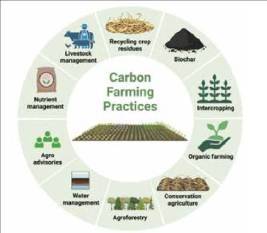MUMBAI, 16 June 2025: In the global fight against climate change, carbon credits have emerged as a vital economic tool to reduce greenhouse gas emissions. They offer a market-driven approach to incentivize climate-positive actions, especially in emerging economies like India, which holds immense potential to generate and trade carbon credits.
As the world moves toward net-zero targets, India’s carbon credit ecosystem presents both environmental and economic opportunities — from empowering rural communities to attracting global investment in green technologies.
What Are Carbon Credits?
A carbon credit represents one metric ton of carbon dioxide (CO₂) or its equivalent in other greenhouse gases (GHGs) that is reduced, avoided, or removed from the atmosphere. These credits can be:
Compliance Credits (regulated markets like EU ETS)
Voluntary Credits (companies offset emissions beyond legal requirements)
Buyers include corporations aiming to meet ESG goals, governments, and sustainability funds.
India’s Role in the Global Carbon Market
India is the world's third-largest emitter, but it also possesses immense natural and renewable resources. The country has committed to reaching net zero by 2070 and reducing the emission intensity of GDP by 45% by 2030, under its Nationally Determined Contributions (NDCs).
This creates a fertile ground for developing a robust carbon credit ecosystem, especially in sectors like:
Renewable Energy (solar, wind, hydro)
Forestry and Land Use (afforestation, mangrove restoration)
Agriculture (biochar, regenerative farming)
Waste Management (methane capture, composting)
Energy Efficiency (LEDs, green buildings, EVs)
Why Carbon Credits Are Important for India
1. Economic Incentives for Green Projects
Carbon credits provide an additional revenue stream for projects that reduce emissions. For example, a solar park or a methane capture facility can earn credits and sell them internationally or domestically.
2. Foreign Investment and Technology Transfer
A transparent carbon market attracts foreign direct investment (FDI) and green technology transfer, helping Indian industries modernize while meeting sustainability goals.
3. Boosting Rural and Farmer Income
Agroforestry, biochar, and regenerative farming practices can generate carbon credits for small and marginal farmers, offering extra income and improving soil health.
4. Global Climate Leadership
India can position itself as a leader in the South-South climate collaboration by becoming a hub for low-cost, high-impact carbon mitigation projects.
Notable organisations working with farmers
Grow Indigo: A joint venture between Mahyco and Indigo Ag, Grow Indigo focuses on promoting regenerative agriculture among Indian farmers. Their carbon program enables farmers to earn income by adopting practices like reduced tillage and direct seeding. The initiative includes educational resources such as "Carbon Kaksha" to guide farmers through the carbon credit process.
Boomitra: Boomitra collaborates with local organizations to help farmers adopt sustainable practices that enhance soil carbon. Their URVARA Project has issued soil carbon credits to over 6,000 smallholder farmers across 25,000 acres in India, providing direct financial benefits and improving soil health.
Varaha: Varaha partners with smallholder farmers in South Asia to implement regenerative farming practices that sequester carbon in the soil. The company has onboarded over 80,000 farmers, covering 700,000 acres, and has secured agreements with companies like Google to purchase carbon credits generated from these practices.
CIMMYT and ICAR: The International Maize and Wheat Improvement Center (CIMMYT) and the Indian Council of Agricultural Research (ICAR) are collaborating to establish carbon markets for smallholder farmers in India. Their initiative focuses on reducing greenhouse gas emissions and encouraging climate-smart farming practices through financial incentives.
ClimateCare: Operating in India, ClimateCare works on projects that cut carbon emissions and fund social development. They provide carbon offset services and support sustainable development programs, aiming to improve environmental and social outcomes.
IndusInd Bank: IndusInd Bank has piloted a program using the Reserve Bank of India's e-rupee to manage payments to farmers for carbon credits. This initiative aims to streamline transactions and enhance the efficiency of carbon credit payments to farmers.
Opportunities in the Indian Carbon Credit Ecosystem
1. Voluntary Carbon Markets (VCM)
With increased corporate climate pledges, VCMs are booming. Indian startups, NGOs, and agritech firms are launching community-based carbon projects, especially in agroforestry and clean cooking.
Example: Farmers growing trees under agroforestry programs can earn up to INR 10,000 per acre/year via carbon credits.
2. Digital MRV (Measurement, Reporting & Verification)
New opportunities lie in AI-powered MRV platforms that make carbon measurement transparent and scalable. Startups like Cervest, Pachama, and Terra.do are exploring this space.
3. Carbon Credit Exchanges
India announced plans to launch a domestic carbon trading market by 2026. This will allow energy-intensive industries to trade credits and incentivize emission reduction.
4. Sustainability Consulting and Advisory
As more companies aim for net-zero, there's rising demand for carbon accounting, lifecycle analysis, and ESG reporting services — a massive opportunity for climate tech and consulting firms.
5. Blockchain and Tokenized Carbon Credits
Web3 projects are exploring tokenized carbon credits, making them more liquid, traceable, and democratized. Platforms like Toucan Protocol and KlimaDAO have global interest — and India could benefit by building localized versions.
Government Support and Policy Framework
Energy Conservation (Amendment) Act, 2022: Legalizes the carbon credit trading scheme in India.
Perform, Achieve and Trade (PAT) Scheme: Encourages industrial energy efficiency with tradable energy-saving certificates.
National Bio-Energy Mission: Promotes bioenergy projects that can earn carbon offsets.
India's National Carbon Registry (coming soon): A unified platform for carbon credit tracking and certification.
India is also aligning with global standards like Verra, Gold Standard, and GS VER, ensuring credibility in international markets.
Challenges to Watch
Lack of standardized MRV practices in rural and land-use sectors
Awareness gap among farmers and local project developers
Risk of “greenwashing” and low-quality credit generation
Delays in policy rollout and approval timelines
Need for better training and capacity building at the grassroots level
A Green Goldmine for India
Carbon credits are more than just an environmental instrument — they represent a green economic opportunity. With the right mix of policy support, digital innovation, and grassroots participation, India can become a global hub for high-quality, nature-based and tech-enabled carbon credits. It’s a chance to empower communities, attract green capital, and lead the next wave of climate action — while building a resilient and inclusive economy.
By Jagdish Kumar
Image credit: Researchgate




















